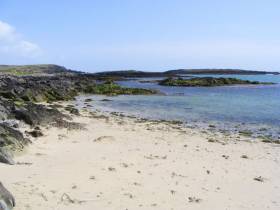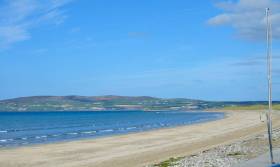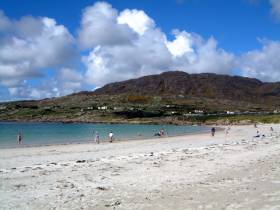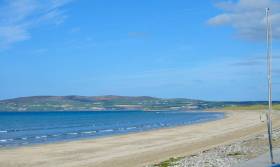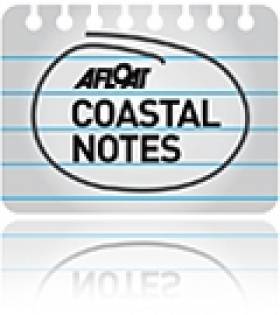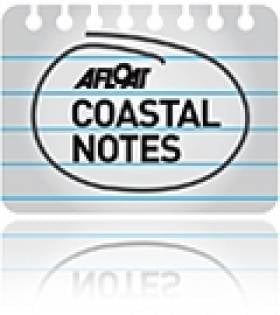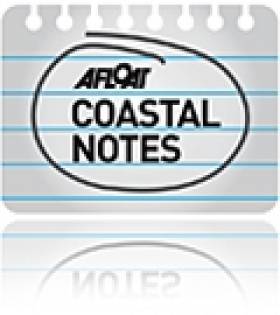Displaying items by tag: beaches
Adapting Beaches and Dunes for Climate Change Funded Under Government Community Programme
Training for communities in preparing Irish beaches and dunes for climate adaptation is one of 18 projects funded under the Government’s community climate action programme.
The project on beaches and dunes is being led by Leave No Trace Ireland, and aims to “build the capacity of local communities to adapt to, and mitigate against, climate change”.
The project leaders say it will develop a toolkit and educational workshops which will “build the knowledge and skills of communities to take positive action on how best utilise beaches and dunes as coastal protection”.
The project is being run as a partnership with the Atlantic Seaboard North Climate Action Regional Office; the Mayo, Sligo and Leitrim Education and Training Board; and University of Galway.
"There is a massive appetite to take action at individual and community levels"
Minister for the Environment, Climate and Communications Eamon Ryan announced the 18 successful recipients of the new €5 million fund under strand 2 of the Community Climate Action Programme in Dublin on Thursday (Oct 27).
The Community Climate Action Programme supports projects and initiatives that facilitate community climate action through education, capacity building and learning by doing.
The programme is being run by Pobal, on behalf of the department.
“There is a massive appetite to take action at individual and community levels,” Mr Ryan said.
“The Climate Conversations 2022, which my Department undertook over the summer to get a sounding on where people are at, found that 83% of participants across Irish society are motivated to take action to address climate change,”he said.
“The range of projects represented in these awards is an indication of this appetite for initiatives that can help communities move towards a more sustainable future,”he said.
“I’m looking forward to seeing the lasting impact the projects will have in empowering communities to change behaviours and habits, and am confident the outcomes will inspire other groups who may wish to participate in further funding strands,” he said.
The 18 projects from around the country were selected from 72 applications, and represent a diverse range of activities across the five programme themes (home and energy; food and waste; shopping and recycling; transport; local climate and environment).
More information on the projects is here
The West is Best in Lonely Planet’s List of Top Irish Beaches
The Wild Atlantic Way is a winner when it comes to Lonely Planet’s new list of the 10 best beaches in Ireland.
All but two of travel writer Fionn Davenport’s selections can be found along the breathtaking coastline from Kerry to Donegal.
And the North West especially comes out tops, taking up half the list with renowned beauty spots such as Keem Beach and Trawmore Bay on Achill Island on Co Mayo, Streedagh Strand in Co Sligo, and Trá Mór and Ballymastocker Bay in Co Donegal.
Only two beaches bust the trend. Ballyquin Beach in Co Waterford holds up for the South Coast, and Killiney Beach on Dublin Bay is the only representative for the East Coast.
Find out more about the list on the Lonely Planet website HERE.
Ireland is a veritable bounty of beautiful beaches, as TripAdvisor’s latest list of Ireland’s best can attest.
But beyond the most highly rated bathing spots around the Irish coast, there exists a number of hidden gems to attract those seeking something a little more special.
And according to TheJournal’s list of Ireland’s best ‘secret beaches’, they could be “hiding right under your nose”.
Walk a little off the beaten track from some of Ireland’s most popular seaside tourist attractions and you will find breathtaking scenes at Ballyteige Burrow (near Kilmore Quay), Galley Cove (in Crookhaven) and Portally Cove (near Dunmore East).
The islands of Ireland’s Wild Atlantic Way are a treasure trove of mini paradises such as Furnish Island in south Connemara and Inishbofin’s East End Beach.
And even those closer to the capital have the likes of Wicklow’s Seal Beach and Poolbeg’s Shelly Banks virtually on their doorstep.
TheJournal.ie has more on the story HERE.
Kingdom Of Kerry Rules Over TripAdvisor’s Best Irish Beaches List For 2019
#TopBeaches - Kerry dominates TripAdvisor’s list of the best Irish beaches for 2019, with the Kingdom taking six of the top 10 places.
Ladies Beach at Ballybunion (9th), Coumeenoole (6th), Derrynane (5th) and Inch Beach (3rd) all make return appearances in the travel website’s selection, with Rossbeigh (8th) making the grade for the first time.
Past favourite Banna Strand is the most popular of the county’s sandy stretches — but this year plays second fiddle to another popular destination for TripAdvisor users, Inchydoney in Co Cork.
Strandhill in Co Sligo at 4th and Lahinch in Co Clare complete the top 10 along with Portmarnock in Co Dublin, the only East Coast entry, as Independent.ie reports.
‘Amazing’ Irish Beaches To Explore When Fine Weather Returns
#TopBeaches - The weather might not agree but summer isn’t over yet, and there’s still plenty of time to explore Joe.ie’s pick of amazing beaches around the Irish coast.
Seaside beauty spots like Inch Beach in Co Kerry (famous for Ryan’s Daughter), Curracloe in Co Wexford (a key location for Saving Private Ryan) and Inchydoney in Co Cork will be familiar to Irish holidaymakers and foreign tourists alike.
But Dog’s Bay — south of Clifden in Connemara, and a standout both for its horseshoe shape and white sand — might be a new addition to your beaches list.
Surfing enthusiasts are also catered for at Ballycastle in Co Antrim and Strandhill in Co Sligo, locations that may see an uptick in wave-seeking visitors as it emerged that Ireland is now the cheapest country in Europe for surf lessons.
Earlier this year, Kerry’s Banna Strand topped TripAdvisor’s list of Ireland’s best beaches.
Banna Tops List of TripAdvisor’s Best Irish Beaches
#TopBeaches - Banna Strand in Co Kerry has topped TripAdvisor’s list of Ireland’s best beaches.
The stretch of sand on Tralee Bay takes the top spot in the annual table from second-placed Inchydoney in Co Cork, which had been the travel website user’s favourite for the last three years running.
West coast beaches dominate the top 10, and the Kingdom claims most of all, taking third (Derrynane), fourth (Inch Beach) and sixth places (Coymeenoole).
But strands in Sligo, Connemara, Donegal and Curracloe in Co Wexford also made the cut, as Independent.ie reports.
94% Of Irish Beaches Meet Stricter Bathing Quality Standards
#CoastalNotes - Ireland gets an 'A' for seaside bathing, as 94% of beaches have met the EU's new stricter water quality standards.
And as RTÉ News reports, three out of every four Irish beaches have been rated as 'excellent' on the new scale for levels of microbiological contaminants, which is "twice as strict" as in previous years.
But seven out of 136 bathing places monitored by the Environmental Protection Agency (EPA) in 2014 still failed the test.
Youghal in Cork, Clifden and Ballyloughane in Galway, Rush's south beach in North Co Dublin, Duncannon in Wexford, Ardmore in Waterford and Liliput on Lough Ennell in the Midlands were all rated 'poor', for the most part due to wastewater discharges.
Ten other popular seaside spots – including Trá na mBan in Spiddal and the beaches at Merrion Strand, Loughshinny and Balbriggan's front strand in Co Dublin - were rated as 'sufficient' as they are still prone to periodic pollution episodes, according to The Irish Times.
But there was good news for the denizens of Trá Inis Oirr in Galway Bay, which scored an 'excellent' rating in its first year on the EPA's list.
The Aran Islands beach was added in the same year that nearby Trá gCaorach became a first-time winner in the National Green Coast Awards.
The EPA's Splash website maps out the latest bathing quality ratings for beaches around and throughout Ireland. The agency's report on bathing quality in 2014 can be found HERE.
#OnTheWater - This week's unseasonably fine weather saw thousands flock outside to enjoy the sunshine - and many of them headed to Ireland's finest beaches, some of which were highlighted by JOE.ie.
Among the most beautiful stretches of sand selected by the website include Brittas Bay – a perennial favourite in Dublin and Wicklow alike – as well as Inchydoney in West Cork, surfers' choice Tullan Strand in Bundoran, and the sheltered calm of Keem Beach on Achill Island.
All are recommended for their relaxing potential and arresting views as much as for swimming.
But one place where swimming is definitely not recommended is at Dublin's Docklands, where young people were seen leaping from a quayside roof into the River Liffey yesterday (Friday 10 April).
TheJournal.ie has an image of the group jumping from the roof of a restaurant on North Wall Quay just west of the Samuel Beckett Bridge, flying over the heads of unsuspecting passers-by on the footpath below.
The Irish Coast Guard has reiterated previous warnings "not to engage in this particular type of activity" which amounts to "literally jumping into the unknown".
Inchydoney Tops 'Best Beach' List For Second Year Running
#Beaches - And the title of Ireland's best beach goes to... Inchydoney in West Cork, as TheJournal.ie reports.
This marks the second year in a row that the Clonakilty strand took the top spot in TripAdvisor's annual ranking of Ireland's beaches, as chosen by visitors and tourists giving their ratings on the site.
It couldn't come at a better time for Inchydoney, as next month signals the start of the best period of the year to make the most of its peaceful atmosphere.
Elsewhere on the top ten list, Kerry places the most with four beaches making the grade - including Derrynane and Inch at numbers two and three respectively.
But the east coast also gets a look-in, with Curracloe in Wexford placing sixth, and Portmarnock in North Co Dublin rounding out the list at number 10.
TheJournal.ie has much more on the story HERE.
Bathing Bans For More East Coast Beaches
#BathingBan - Following the news of swimming bans at Killiney and Sandycove Harbour, The Irish Times reports on similar advisories on more beaches on the east coast coming after last weekend's heavy rain.
Elevated bacteria levels have been detected this week at Bettystown in Co Meath, Clogherhead and Templetown in Co Louth, Dollymount Strand on Bull Island, Howth's Claremont Beach and Loughshinny Beach between Rush and Skerries.
All locations have been retested with results awaited within the next few days. Contamination from floodwaters is suspected to be the most probable cause.
The Irish Times has more on the story HERE.




























